As a firefighter begins to learn and understand thermal imaging cameras, they come to an interesting conclusion. Each one brand/model has unique differences such as when they show color regarding color/temperature correlations.
In general, firefighters tend to correlate gray or black with cooler temperatures. However that is not always the case with certain models and brands. Typically, darker gray something is the cooler that surface will be as compared to the surrounding ones. The colors then move through shades of whites, yellows, and reds which are the hottest areas seen in the camera’s view. While the color palettes of various TIC’s follow a general pattern there is no industry standard that specifies what temperature a specific color will appear as.
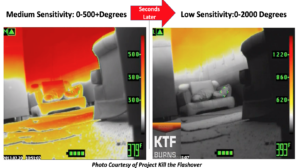
Firefighters must understand that thermal imaging isn’t a one-size-fits-all type of activity. It requires using all the information present and applying the appropriate actions. For instance, an object appearing white can be more than hot enough to burn you or to contribute to the combustion process of a material such as the following image.
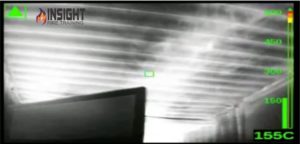
On the other hand, an object can show white yet not be hot at all. We’ve all looked throug h a TIC and seen a firefighter standing across from us in the bay or sitting in a classroom. Though they show up as white they certainly aren’t hot enough to burn; they just happen to be the hotter surface in the room. In the case of structure fires, white is often an indicator that there is heat present; our job is to narrow down what that source may be. But just like the examples above, things are not always as they seem.
Consider these next photos. If we were looking for are as that may be emitting or radiating heat energy, we would focus on the white section beside the window on the left.
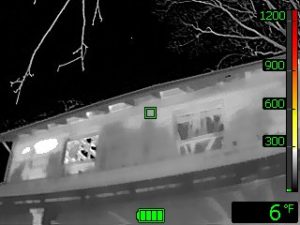
We might think we had fire in that wall. In this next photo, there is bright white to the top right of the window. Our knowledge of building construction tells us that the tops and sides of windows are classic places for fire to hide in the voids of the frame. Looking at the color palette this white may be in the neighborhood of *300; definitely a temperature and location that would make you think you had hidden fire. There are also some lighter colors to the lower right as well as along the soffit line that might give the impression that the surface is being heated internally. But remember, things are not always as they seem. These are not showing radiation, they are showing reflectivity. Specifically, it’s the reflectivity of the sun on aluminum siding.
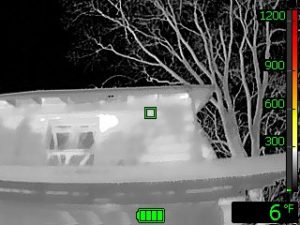
The surface of the aluminium siding is shiny and smooth. In technical terms, it means the siding has low emissivity (or how a surface radiates heat) Another way of putting it is how a surface absorbs heat.
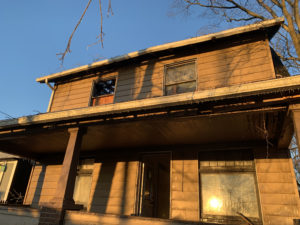
It is critical to remember that surfaces with low emissivity have high reflectivity. In this case, the sun is reflecting off the shiny smooth surface of the aluminum and into the lens of the camera. That’s the apparent temperature that is being read by the TIC and the reason that the surface appears much hotter than it really is. A surface like this (low emissivity) can lead to highly inaccurate temperature readings. A mantra to remember is “if it’s shiny it may burn your hiney.” can’t recall if you have a second portion to this that deals with high emissivity! In other words, things aren’t always as they seem. But it’s not just the sun on a shiny metal surface that can be a false indicator.
In this photo our eyes tell us that the soffit on the left and the roof decking on the right are radiating a large amount of heat. Those surfaces are certainly not shiny or smooth but darker and rough.
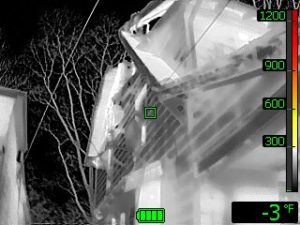
So what’s causing the inaccurate apparent temperatures here?
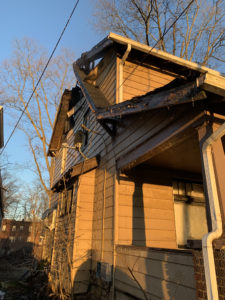
It’s the sun again but this time its reflecting off the ice that has formed on those surfaces. We’re well aware that spraying water in below freezing temperatures causes ice to form. This is creating that shiny surface for the sun to reflect off and into the TIC. Too many firefighters are only focused on looking for red as a sign of heat when they look through a TIC. Using colorization as a sole means of gauging thermal severity could be a grave mistake.
The fire service needs to learn that there are more colors that can be dangerous than just red, and white is one of them. However, as we’ve seen, white may not always be bad. Things aren’t always as they seem. So get educated. Learn how to use the TIC’s that your department has. Know their intended uses and understand their inherent limitations. The TIC is a valuable tool but to borrow the phrase from EMS “treat the patient not the monitor.” In other words, don’t just view things through the screen of the TIC, look at all the information present and make an informed decision on the next best course of action. Look at the area in question and rule out things like emissivity or reflectivity. When in doubt, check it out. After all, the TIC is only as useful as the person holding it.
Contact the instructors of InsightTrainingLLC and their partners for more information.
Instructor John Lightly
Insight Training LLC
Level I Thermography Certified
